10 easy home made DIY fertilizers for your plants
Easy home made DIY fertilizers for your plants offer a sustainable and cost-effective approach to garden nourishment. Harnessing readily available items like banana peels, coffee grounds, and eggshells, these solutions enrich soil, enhance plant health, and promote eco-friendly gardening, creating a harmonious balance between nature and cultivation for thriving, vibrant greenery.
Summary:
From banana peel fertilizer packed with potassium, phosphorus, and calcium to the calcium-rich eggshell fertilizer guarding against blossom end rot, easy home made DIY fertilizer for your plants brings a unique set of nutrients and advantages to the table. Coffee grounds energize growth with nitrogen and phosphorus, while Epsom salt solution bolsters magnesium levels for thriving plants. Vinegar adjusts soil pH cautiously, and seaweed fertilizer unlocks micro nutrients and growth hormones. Compost tea nourishes with a microbial boost, molasses solution fuels soil microbial activity, and fish emulsion enriches with protein-rich nitrogen. Each fertilizer contributes to soil health, plant vitality, and a thriving garden ecosystem in its distinct way.
Introduction:
Growing a healthy garden involves several steps, one of which is the enriching and sustainable use of easy home made DIY fertilizers for your plants. Using homemade fertilizers instead of store-bought ones has various benefits for your plants and the environment. Let’s look at 10 easy home made incredibly productive fertilizers that will enhance your gardening experience.
Importance of using home made fertilizers:
Homemade fertilizers embody a sustainable approach that minimizes reliance on chemical-laden alternatives. By harnessing natural elements readily available in our surroundings, these fertilizers offer a viable alternative that’s both cost-effective and eco-friendly. They facilitate a harmonious synergy between plant nourishment and environmental stewardship. Understanding the distinct advantages of each homemade fertilizer empowers gardeners to tailor their nourishment, fostering a healthier, more resilient garden ecosystem.
10 Easy home made DIY fertilizers:
10 easy home made DIY fertilizers for your plants are as follows:
1-Coffee grounds fertilizers:
The components that remain from your morning coffee are a secret source of nutrients for your plants. Coffee grounds provide your plants with a natural boost and special considerations for best use because they are rich in nitrogen, phosphate, and trace elements.
Nutrient Profile: Nitrogen, Phosphorus, and Trace Elements:
You may enrich your soil with nutrients by adding coffee grounds. Nitrogen, a crucial component for plant growth, aids in leaf development and overall vitality. Phosphorus contributes to root growth and flower production, while the trace elements present in coffee grounds enhance soil fertility, nurturing a thriving ecosystem for your plants.
Utilizing Coffee Grounds for Acid-Loving Plants
Coffee grounds have a unique quality: they are a bit citric which makes them perfect for plants that like acid, like blueberries, rhododendrons, and azaleas. Adding these grounds to the soil promotes the growth of plants that do well in an acidic environment by keeping it at an optimal level.
Precautions Against Overuse and Potential Problems
While coffee grounds offer numerous benefits, moderation is key. Excessive use of coffee grounds can lead to an imbalance in soil pH, potentially hindering the growth of certain plants. Additionally, their compact nature might impede water penetration in the soil if not properly mixed, resulting in water logging. Thus, it’s advisable to use coffee grounds sparingly and ensure proper integration into the soil.
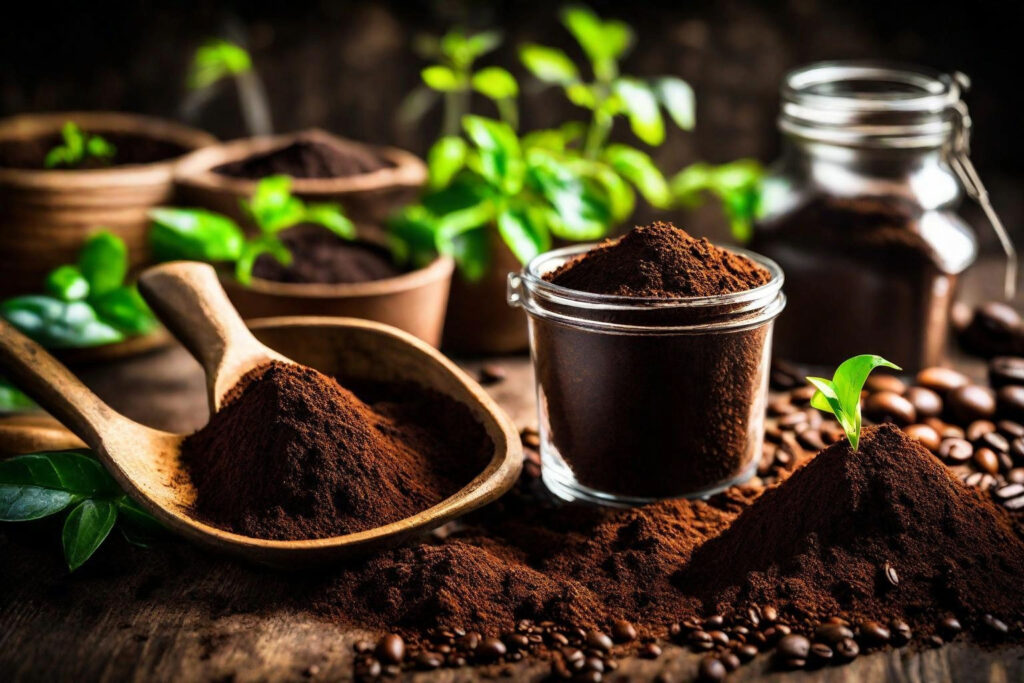
2-Eggshell Fertilizer:
Eggshells, often disregarded after their culinary use, harbour immense potential as a easy home made DIY fertilizers, particularly due to their calcium-rich composition and multifaceted benefits for plant growth.
Calcium-Rich Composition and Its Impact on Soil pH:
Eggshells serve as a valuable source of calcium, essential for fortifying soil structure and fostering optimal pH levels. As these shells break down, they impart calcium into the soil, addressing deficiencies and promoting a balanced pH environment. This balanced pH creates a favourable setting for plant roots to access vital nutrients, ensuring healthy growth and development.
How Eggshells Prevent Blossom End Rot in Tomatoes:
Blossom end rot, a common issue in tomatoes, stems from calcium deficiency. Eggshell fertilizers act as a preventive measure against this condition by supplementing the soil with the much-needed calcium. This supplementation fortifies the tomatoes’ cell walls, mitigating the risk of blossom end rot and ensuring the fruits develop healthily without unsightly rotting at their base.
Grinding Methods for Effective Soil Incorporation
To maximize the benefits of eggshell fertilizers, crushing or grinding the shells into fine particles is advisable. This process aids in quicker decomposition and incorporation into the soil. Finely ground eggshells facilitate efficient absorption of calcium by plant roots, ensuring a steady and sustained release of nutrients for optimal growth.

3-Epsom Salt Solution fertilizer:
Epsom salt, scientifically known as magnesium sulphate is easy home made DIY fertilizers emerges as a natural supplement that plays a pivotal role in nurturing robust plant growth. Understanding its benefits and optimal usage can significantly elevate your garden’s health.
Magnesium, Sulphate and Its Role in Photosynthesis:
Epsom salts work because magnesium is an essential component of chlorophyll, the pigment that is responsible for photosynthesis. This vital nutrient aids in photosynthesis, which allows carbon dioxide and water to be transformed into sugars that are high in energy and essential for plant growth and vitality.
Boosting the Production of Chlorophyll and the Absorption of Nutrients:
The application of Epsom salt enables plants to absorb essential nutrients more effectively. By boosting magnesium levels, plants enhance their chlorophyll production, promoting vibrant, lush foliage and robust growth. This augmentation in chlorophyll synthesis also aids in the plant’s ability to withstand environmental stressors.
Recommended Dilution Rates and Application Frequency:
When using Epsom salt as a fertilizer, it’s crucial to maintain the appropriate dilution rates and application frequency. A general guideline recommends dissolving 1 to 2 tablespoons of Epsom salt in a gallon of water for foliage spraying or soil application. This solution can be applied every two to four weeks during the growing season, ensuring a steady supply of magnesium to your plants without risking overuse.
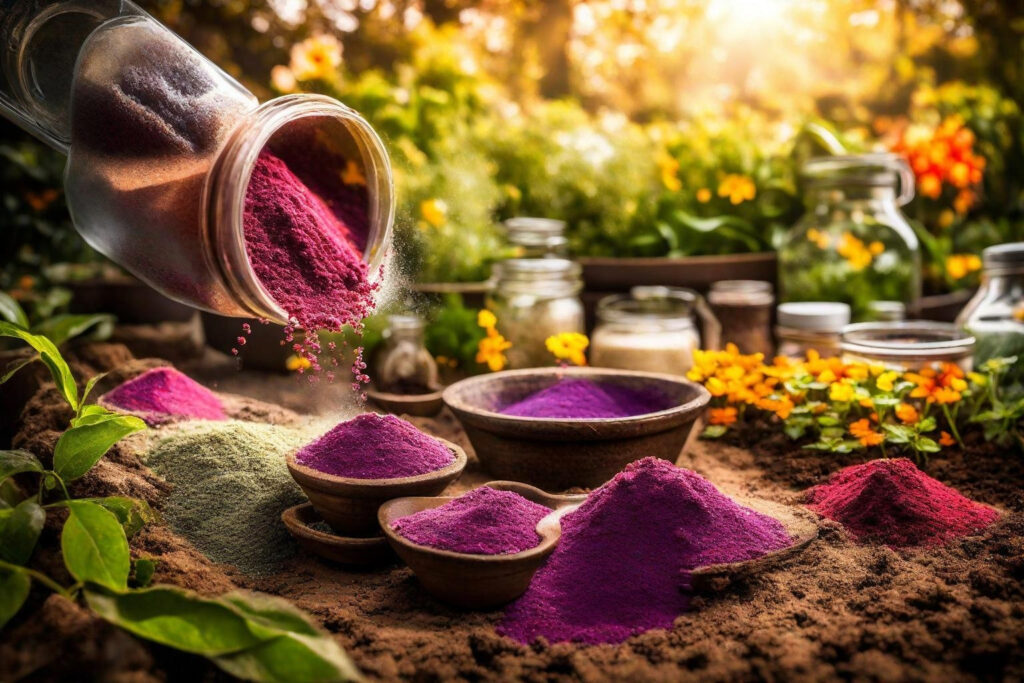
4-Banana Peel Fertilizer:
Banana peels, often tossed aside as waste, hold an impressive array of nutrients vital for plant growth. Rich in potassium, phosphorus, and calcium, these peels are an organic reservoir waiting to nourish your garden.
Nutrient Content: Potassium, Phosphorus, and Calcium:
Within these humble peels lies a treasure trove of nutrients essential for healthy plant development. Potassium fosters robust root systems, aids in disease resistance, and supports overall plant vigour. Phosphorus plays a pivotal role in energy transfer, promoting flowering and seed development. Calcium, another crucial element found in banana peels, bolsters cell walls, enhancing plant structure and resilience.
Decomposition Process and Release of Nutrients:
As banana peels decompose, they gradually release these nutrients into the soil. The breakdown process allows for a steady, slow release of potassium, phosphorus, and calcium. This gradual nutrient dispersion ensures a sustained supply, feeding the soil and plants over an extended period.
Benefits for Flowering and Fruit-Bearing Plants:
For flowering and fruit-bearing plants, banana peel fertilizer acts as a natural booster. The potassium content aids in flower formation and fruit development, promoting larger, healthier yields. Additionally, the phosphorus and calcium contribute to sturdy blooms and robust fruit growth, enhancing the overall quality of the harvest.
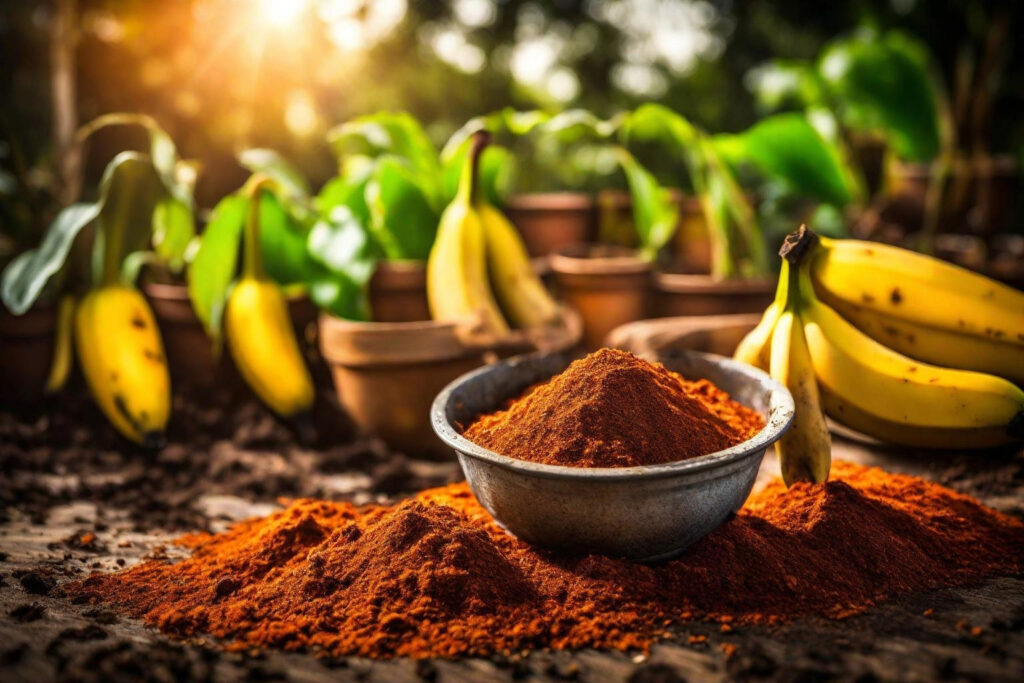
5-Vinegar Fertilizer:
Vinegar, commonly found in households, mostly used as easy home made DIY fertilizers possesses acidifying properties that can be harnessed as a soil amendment. However, its application requires careful consideration and adherence to safe usage guidelines due to certain associated risks.
Adjusting Soil pH: Vinegar’s Acidifying Properties:
Vinegar, primarily composed of acetic acid, functions as an acidifier when applied to soil. Its capacity to lower pH levels makes it suitable for plants that thrive in acidic conditions. By adjusting the soil’s pH, vinegar aids in unlocking nutrients, promoting their availability to plants for optimal growth.
Risks Associated with Vinegar Application:
While vinegar can be beneficial in certain scenarios, its application requires caution. Excessive use of vinegar can result in an overly acidic soil environment, potentially harming plants that do not favour acidic conditions. Additionally, vinegar’s acidic nature may negatively impact beneficial soil microorganisms crucial for healthy plant growth.
Safe Usage Guidelines and Dosage Recommendations:
To utilize vinegar as a soil amendment safely, it’s essential to dilute it adequately before application. A recommended dosage involves mixing one tablespoon of vinegar in a gallon of water for irrigation or soil drenching. Regular monitoring of soil pH levels is advised to prevent drastic fluctuations that may adversely affect plant health.

6-Seaweed Fertilizer:
Seaweed, abundant in our oceans, offers a potent elixir for plant growth, boasting an array of micro nutrients and growth hormones that fortify plants in various ways. Understanding its richness and methods of utilization can greatly benefit your garden.
Seaweed Extract’s Richness in Micro nutrients and Growth Hormones:
Seaweed extract is rich in micro nutrients including iron, zinc, manganese, and growth hormones like auxins, cytokinins, and gibberellins. This nutritious cocktail supports plant health by bolstering their immune systems, promoting cell division, and enhancing overall growth and vitality.
Soil Conditioning and Stimulation of Plant Immunity:
Applying seaweed fertilizer conditions the soil, fostering a healthy microbial environment crucial for nutrient uptake. Moreover, the presence of alginates in seaweed aids in soil structure improvement and water retention. Seaweed’s innate ability to stimulate plant immunity helps plants ward off diseases, ensuring a robust defense mechanism against environmental stressors.
Methods for Harvesting and Processing Seaweed at Home:
Harvesting and processing seaweed for fertilizer can be a straightforward process. Collecting seaweed from clean, unpolluted coastal areas is essential. Once harvested, rinsing the seaweed thoroughly to remove excess salt is recommended. Processing methods can include drying the seaweed for later use or creating a liquid fertilizer by soaking it in water and then straining the solution for application.

7-Compost Tea fertilizer:
Compost tea, derived from nutrient-rich compost, serves as a powerful elixir for enhancing soil health, fostering microbial diversity, and fortifying plants against diseases. Understanding its extraction process and brewing techniques sheds light on its multifaceted benefits.
Extracting Nutrients and Microorganisms from Compost:
Compost tea involves the extraction of nutrients, beneficial bacteria, fungi, and other microorganisms from compost. This process unlocks the diverse array of nutrients present in compost, allowing for their suspension in water, creating a potent liquid fertilizer that promotes robust plant growth.
Benefits for Soil Health and Suppression of Plant Diseases:
Application of compost tea contributes significantly to soil health. It introduces a rich consortium of beneficial microorganisms that facilitate nutrient cycling, improve soil structure, and suppress harmful pathogens. These microorganisms enhance plant immune systems, reducing the likelihood of diseases and promoting a thriving garden ecosystem.
Aerobic vs. Anaerobic Compost Tea Brewing Techniques:
Aerobic compost tea involves brewing in an oxygen-rich environment, fostering the growth of aerobic microorganisms beneficial for plant health. Conversely, anaerobic tea brewing occurs in an oxygen-depleted environment and may contain fewer beneficial microbes, potentially producing a less diverse and effective tea.

8-Molasses Solution fertilizer:
Molasses, often known for its sweetness, unveils its lesser-known role as a soil catalyst, fostering microbial activity and benefiting plant growth through the stimulation of beneficial bacteria and fungi. Balancing its concentration is key to ensuring plant safety while reaping its rewards.
Soil Microbial Activity and Organic Matter Breakdown:
Molasses acts as a carbon source, igniting soil microbial activity and promoting the breakdown of organic matter. This surge in microbial life initiates the decomposition process, enhancing nutrient availability and soil structure. As microorganisms flourish, they transform organic materials into valuable nutrients for plants.
Stimulating Plant Growth via Beneficial Bacteria and Fungi:
The introduction of molasses stimulates the growth of beneficial bacteria and fungi in the soil. These microbes establish symbiotic relationships with plant roots, aiding in nutrient uptake and disease resistance. They assist in breaking down complex compounds, ensuring a steady supply of nutrients for optimal plant growth and vitality.
Balancing Molasses Concentration for Plant Safety:
Maintaining a balanced molasses concentration is crucial for plant safety. While molasses can be highly beneficial, excessive amounts can result in nutrient imbalances or microbial overgrowth, potentially affecting plant health. Diluting molasses adequately before application helps prevent any adverse effects on plants.

9-Fish Emulsion fertilizer:
Fish emulsion, a protein-rich fertilizer teeming with nitrogen, serves as a valuable resource for enhancing soil fertility and fortifying plants. Understanding its nutrient content, application benefits, and appropriate dilution methods aids in maximizing its advantages while managing its distinctive odour.
Protein-Rich Fertilizer and Its Nitrogen Content:
Fish emulsion, derived from fish remains, is a powerhouse of nutrients, particularly nitrogen. Nitrogen, essential for plant growth, aids in leaf development, vibrant foliage, and overall plant vigour. Its presence in fish emulsion acts as a readily available nitrogen source for immediate plant uptake.
Enhancing Soil Fertility and Plant Resilience:
Application of fish emulsion enriches soil fertility by supplementing it with essential nutrients. Its nitrogen content supports healthy root development, improves soil structure, and enhances plant resilience against environmental stressors. Moreover, the organic matter present in fish emulsion promotes beneficial microbial activity in the soil, contributing to overall soil health.
Proper Dilution and Smell Management Tips:
To utilize fish emulsion effectively, it’s crucial to dilute it appropriately before application. Mixing the emulsion with water as per the manufacturer’s recommendations or at a ratio of about 1 part fish emulsion to 4 parts water ensures a balanced nutrient supply without overwhelming plants. To manage its distinctive odour, consider applying it on a windless day or watering the area post-application to mitigate the smell.
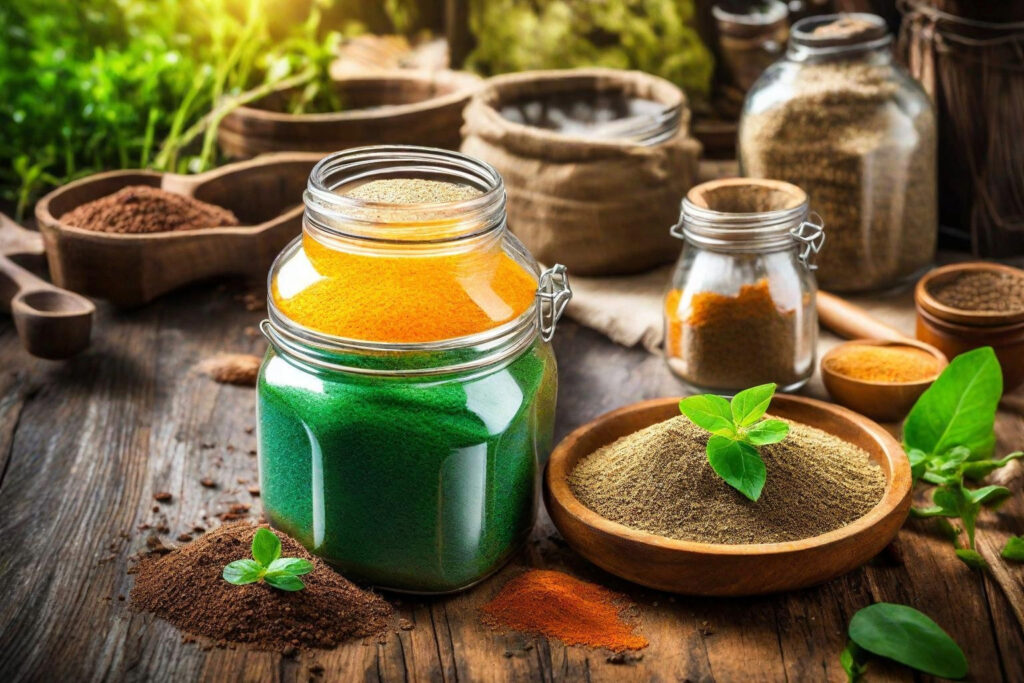
10-Wood Ash Fertilizer:
Wood ash, a byproduct of burned organic materials, offers a treasure trove of potash, predominantly comprised of potassium carbonate and potassium hydroxide. Its rich potash content stands as a key player in nurturing soil health and fostering robust plant growth in gardening practices.
Potash Content and Its Multifaceted Impact:
Potash, primarily found in wood ash, plays a pivotal role in various plant functions. It aids in enzyme activation, regulates water movement within plants, and bolsters photosynthesis. Additionally, potash enhances disease resistance, promotes root development, and contributes to the synthesis of starches and sugars, crucial for plant vitality and overall growth.
Safe and Strategic Use of Wood Ash as Fertilizers:
Utilizing wood ash requires a measured approach to prevent overloading the soil with potassium. Incorporating small amounts into compost piles or spreading a thin layer around plants encourages slow and steady release of nutrients. However, excessive application can lead to alkaline soil conditions, affecting nutrient availability. Monitoring pH levels and avoiding direct contact with plant parts helps maintain a balanced nutrient profile.

Conclusion:
The world of easy home made DIY fertilizers is as diverse as the gardens they nurture, offering a multitude of benefits and possibilities for sustainable gardening practices. As we recap the array of homemade fertilizers and their advantages, let’s also foster a spirit of experimentation and encourage sustainable gardening for a greener future. By nurturing our gardens with sustainable practices, we not only cultivate healthier plants but also contribute to a more sustainable environment. Let’s continue this journey towards greener, more vibrant gardens while celebrating the diversity and wonder of nature.
FAQs

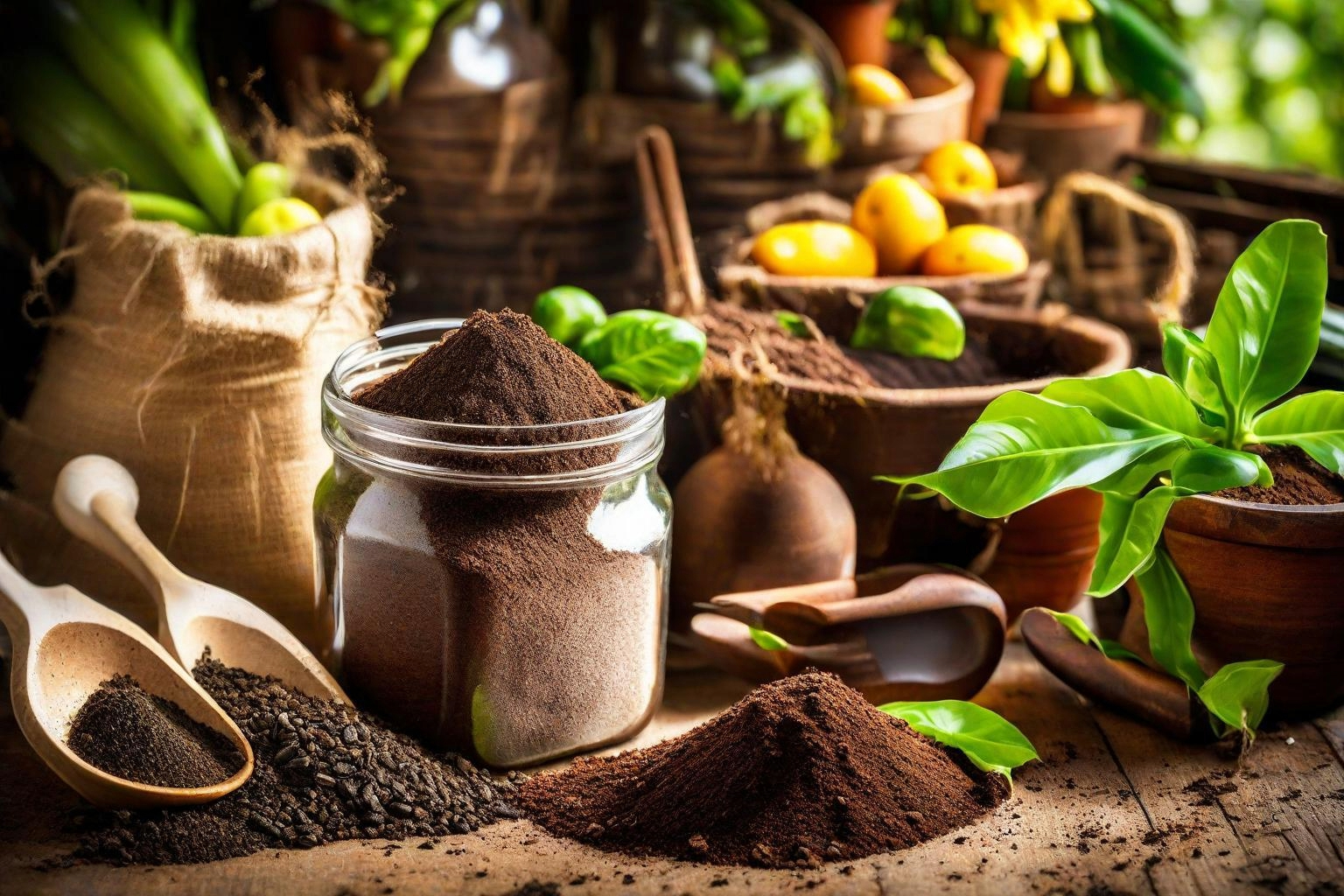





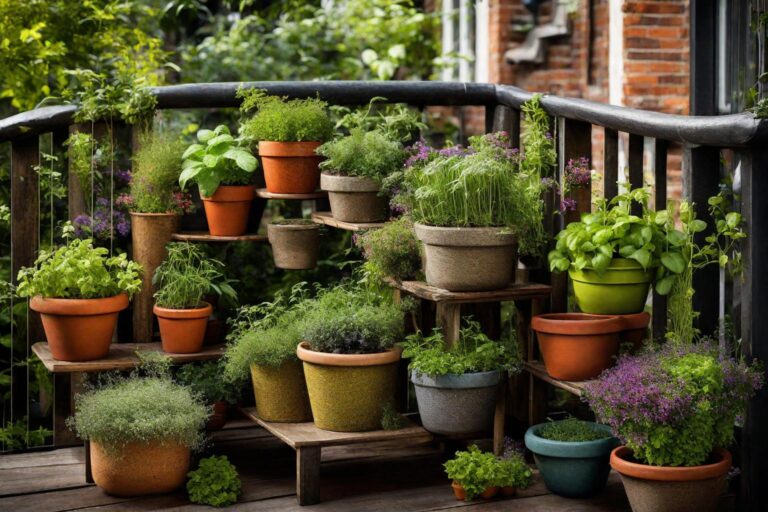
2 Comments